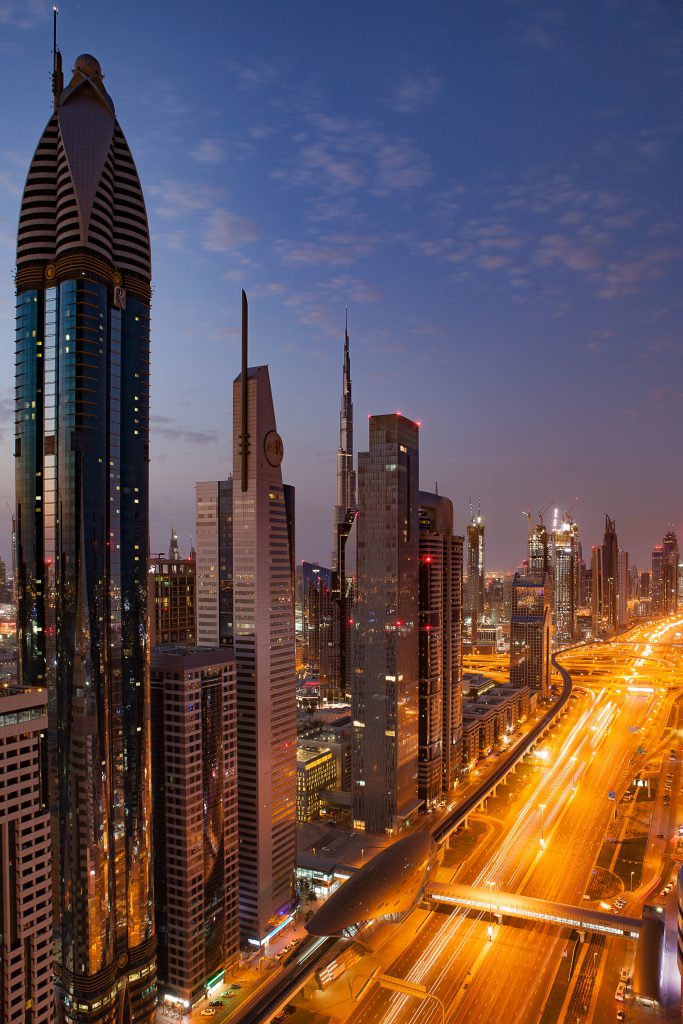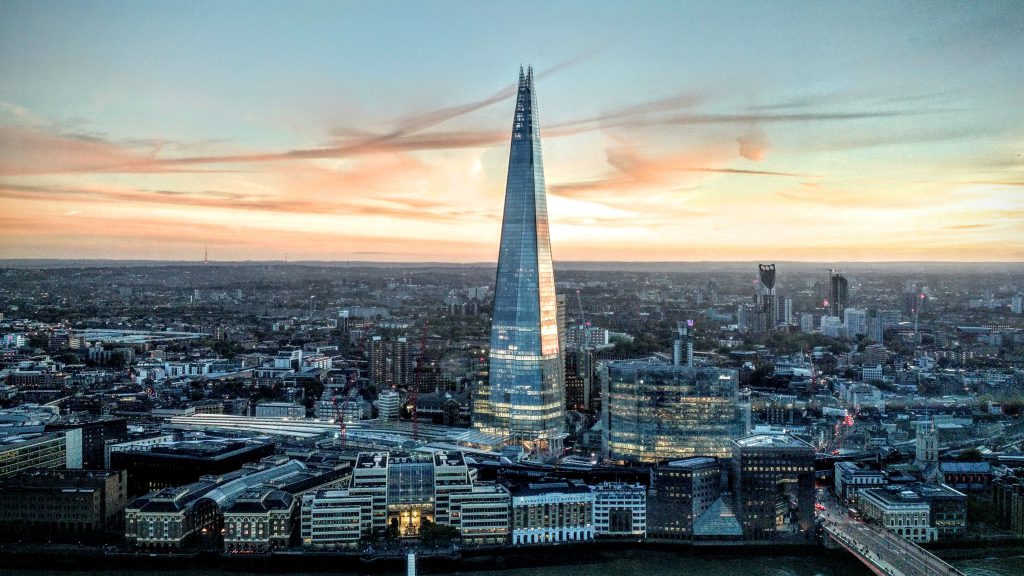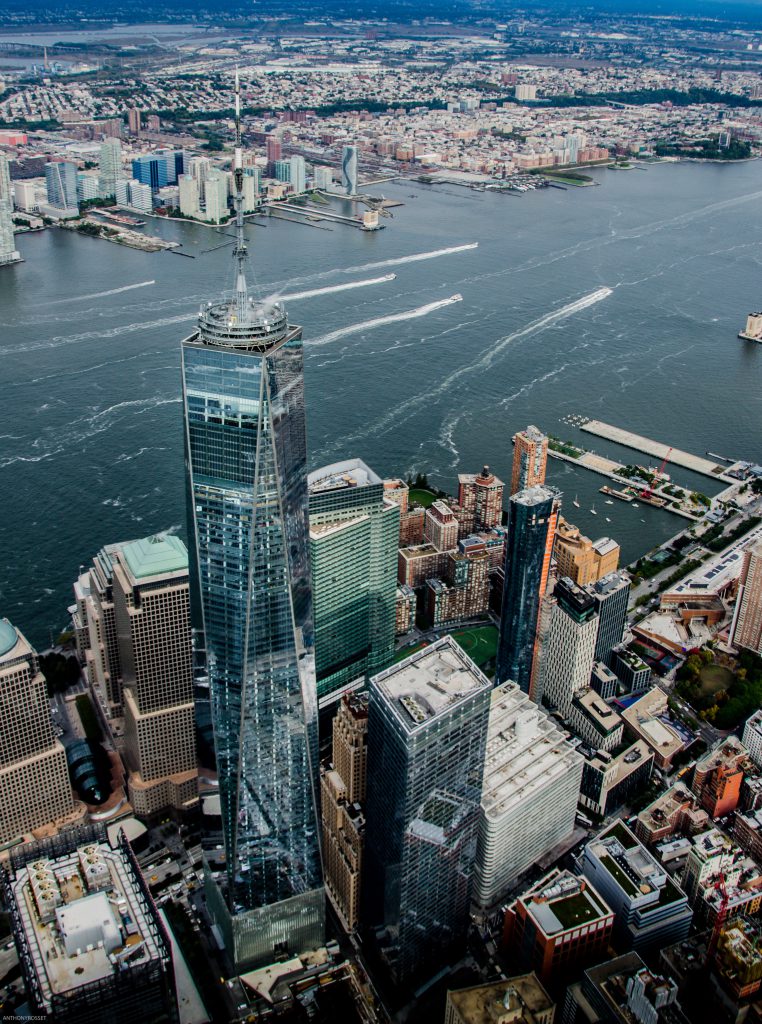From the concrete jungles of the Big Apple and the baked desert cities of the Middle East to Asia’s booming financial hubs, join us on a journey from your sofa to the soaring skyscrapers that have played a huge part in putting the best cityscapes in the world.
Burj Khalifa, United Arab Emirates
The perfect place to kick off is this towering spire of a building: Burj Khalifa. A combination of vision and mathematical precision brought the tallest skyscraper in the world to life, with other credits to its name including tallest free-standing structure in the world, highest observation deck in the world, and elevator with the longest travel distance in the world.
Clocking in at an eye-watering 829.8m, Burj Khalifa’s outline is one of the most recognisable and is inspired by Islamic architecture and mosques of antiquity, while its completion signalled the official opening of Dubai’s entertainment district, Downtown Dubai. It is home to corporate offices, residential apartments, the Armani Hotel, and several observation decks and restaurants. Embark on a virtual exploration of the building here.

Abraj Al Bait, Saudi Arabia
Mecca has welcomed pilgrims since the age of antiquity which is why one of the core philosophies around the construction of Saudi Arabia’s Abraj Al Bait was to help modernise the city for pilgrimage.
Consisting of seven skyscraper hotels and a central hotel tower known as the Makkah Royal Clock Tower, Abraj Al Bait was built mere steps from the Great Mosque of Mecca and is also home to a five-storey shopping mall and two large prayer rooms that can accommodate 10,000 people.
The most notable aspect of the building is its clock faces, which are the largest in the world. Behind the clock faces, you’ll find the Clock Tower Museum along with an astronomy exhibition and a scientific centre used to follow the moon whose appearance is of significance for Islamic celebrations and holy months. You can see more images of the famous clock tower complex here.
The Shard, United Kingdom
Embodying its namesake, one of London’s most iconic contemporary emblems soars heavenward from the busy streets of Southwark before coming to a triumphant, spear-like end some 95 stories and 309.6 metres in the sky.
The Shard’s design was conceived by visionary Italian architect Renzo Piano who imagined a vertical city of mixed use space where people would come to work, shop, socialise and stay. Today, it is home to offices, a retail space, the Shangri-La Hotel at The Shard (which is part of our Global Hotel Collection), and several bars and restaurants where our members enjoy concierge-exclusive perks.
You’ve never seen London until you’ve seen The View from The Shard, but for now you can make the journey virtually with these live east and west webcams.

Empire State Building, USA
Few structures around the world have received quite as much publicity as Midtown Manhattan’s art-deco-era Empire State Building. It is so famed, in fact, that it has appeared in no less than 250 movies along with countless mentions in books and songs since it was built in 1931.
To put its sheer magnitude into perspective in a city of superstructures, the Empire State Building was assigned its own zip code and is one of just 43 buildings in the metropolis to be given this distinction. It was also the first skyscraper on earth to exceed 100 floors with its observation deck welcoming a whopping four million people each year.
2019 saw the reopening of its observation deck on floor 102 after renovations and while you can’t visit it yourself right now, you can admire the view with this live cam
Willis Tower, USA
For 41 years after its completion in 1973, Willis Tower was celebrated as the tallest building in the Western Hemisphere until the One World Trade Center surpassed it in 2014. It welcomes over 1.7 million people to its observation deck, Skydeck, each year and is considered one of Chicago’s bucket list attractions.
Skydeck is the highest of its kind in the US with a major draw being its glass bottom sky boxes. Visitors can experience the building swaying in the wind from that height and see views that extend across the Illinois plains. In clear conditions, Michigan and Wisconsin are visible.
See if you can spot them for yourself with the Willis Tower cam that updates with real-time images every 30 seconds.
One World Trade Center, USA
One World Trade Center is the phoenix that rose from the ashes of 9/11 and forms part of Manhattan’s rebuilt World Trade Center complex. Built on the site of 6 World Trade Center, its architect, David Childs, was also the mastermind behind other architectural greats on this list such as Burj Khalifa and Chicago’s Willis Tower.
One World Trade Center surpasses the Empire State Building in height, making it the tallest structure in New York City with a total height of 546.2m at its tip. Its construction pays tribute to the original Twin Towers through its modernised design echoing its predecessor while its three-storey observation deck offers expansive views of Manhattan’s skyline and an interactive tool called City Pulse shares stories and information about the city. You can admire the view from home through the building’s live earthcam.

Lotte World Tower, South Korea
It’s impossible to mistake Seoul’s skyline with the Lotte World Tower lauding over it. Recognised as the fifth-tallest skyscraper in the world and the tallest in South Korea, its initial design was an almost exact copy of the Eiffel Tower but it changed a total of seven times before its current blueprint was agreed upon.
Lotte World Tower’s terrace and cafe welcomes visitors throughout the year while its Seoul Sky skylight was the highest glass floor observatory in existence upon its completion in 2016. You can find out more about the tower, its view, and construction by clicking here.
International Commerce Centre, Hong Kong
Dominating the skyline of Hong Kong’s West Kowloon district, the International Commerce Centre (ICC) faces its twin across Victoria Harbour, the 2 International Finance Centre (IFC), which together creates an iconic skyline for this island city. Tetraphobia, the practice of omitting instances with the digit 4, is prevalent throughout Hong Kong and impacted the construction of the ICC.
Floors that would have included the number 4 (such as 14, 24, 34) were omitted. The building is home to The Ritz-Carlton, Hong Kong, the sky100 observation deck, five-star restaurants, and the world’s highest swimming pool and bar. You can admire 360-degree views from the comfort of home with this live, interactive webcam.
Shanghai Tower, China
The crowning glory of Shanghai’s Pudong district is not only China’s tallest skyscraper but also its most eco-friendly. Incorporating green architecture across its 128 stories, Shanghai Tower captures rainwater for internal use while its exterior’s unusual 120° twist allowed for 25% less structural steel to be used in construction and has reduced wind loads on the building by 24%. Near the top of the 632-metre tower are 270 vertical-axis wind turbines that provide it with 10% of its electricity needs.
The building’s green credentials continue with internal heating and cooling systems that are powered by geothermal energy sources and compounded by the design’s double-layered insulating facade, which lessens the need for air-conditioning. Visitors normally flock to the tower to make their way up to the highest observation deck on earth using the fastest elevators in the world, but you can enjoy the view from where you are by clicking here.

Ping’an International Finance Centre, China
The second tallest building in China after the Shanghai Tower, Ping’an International Finance Centre in Shenzhen has been lauded as a sky-high city all its own. This supertall skyscraper has a staggering height of 599 metres encompassing 199 stories along with the second-highest observation deck on earth, which clocks in at 562.2 metres.
This structure of steel, stone and glass converges into one point in the sky, moderating the tension of the earth. Its expansive interior houses five floors of retail space, a thriving central business district and restaurants while the ingenious architectural design caters for the weather by reducing wind loads by almost 40%. See the view for yourself and find out more about the building here.


